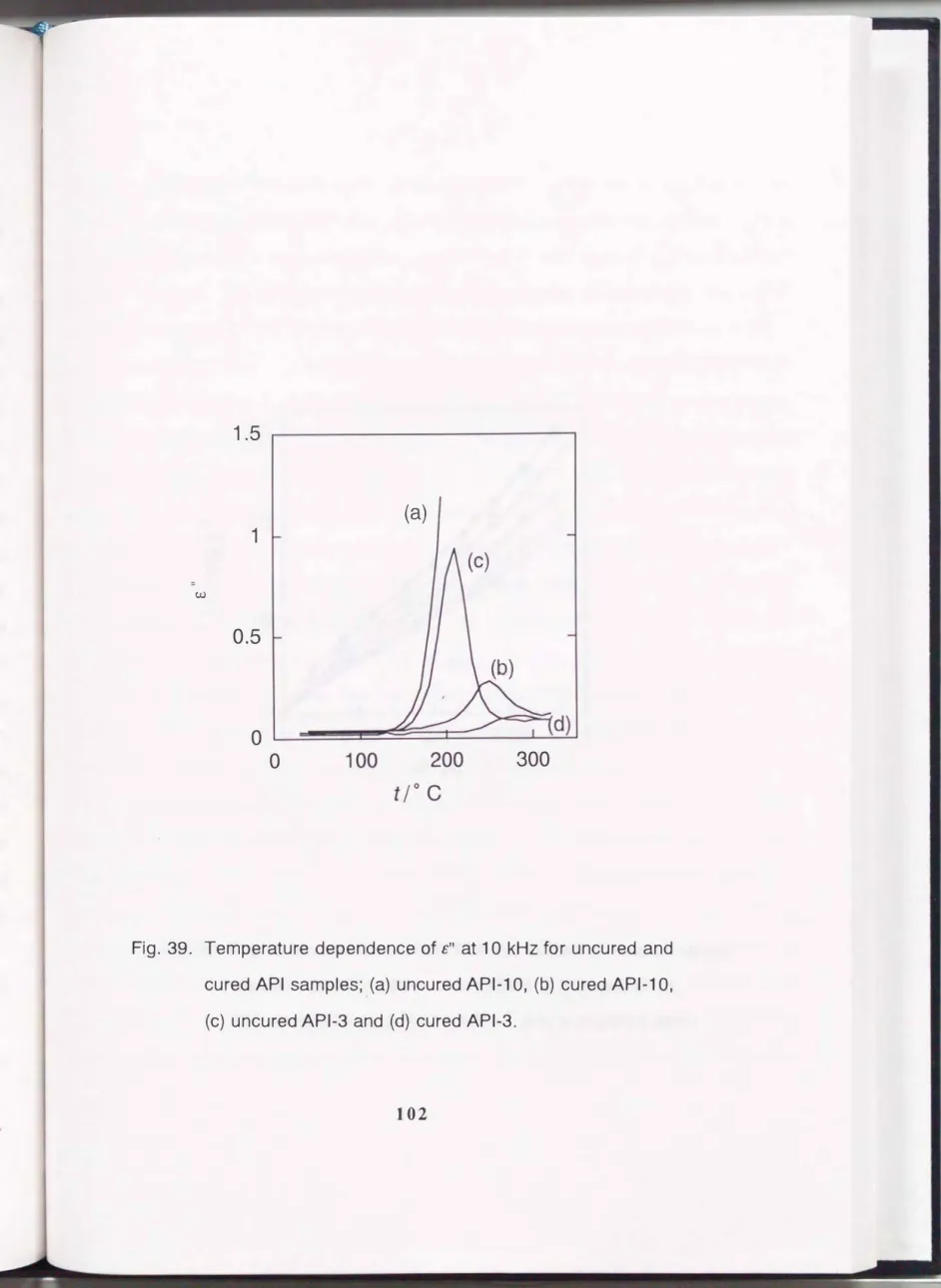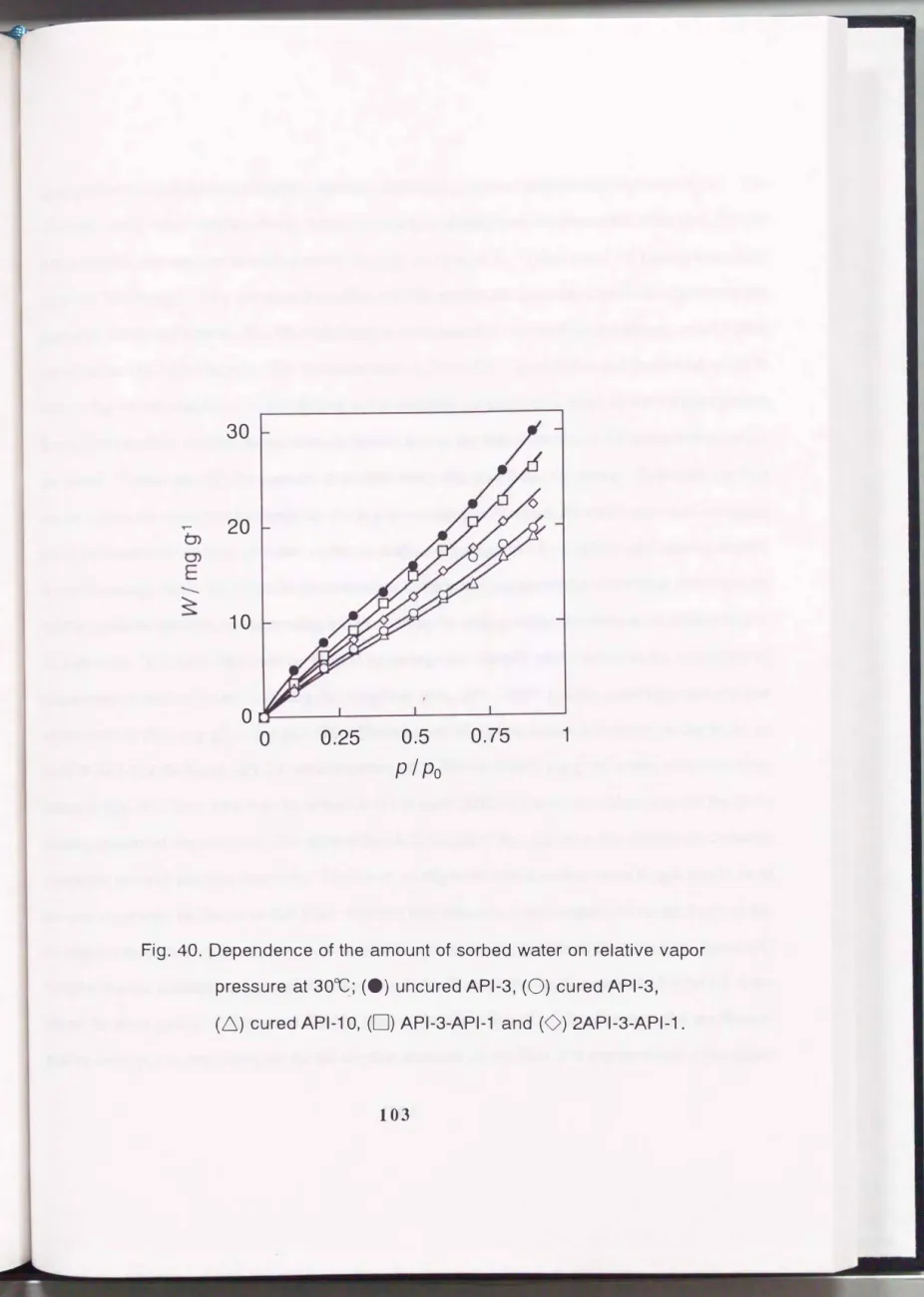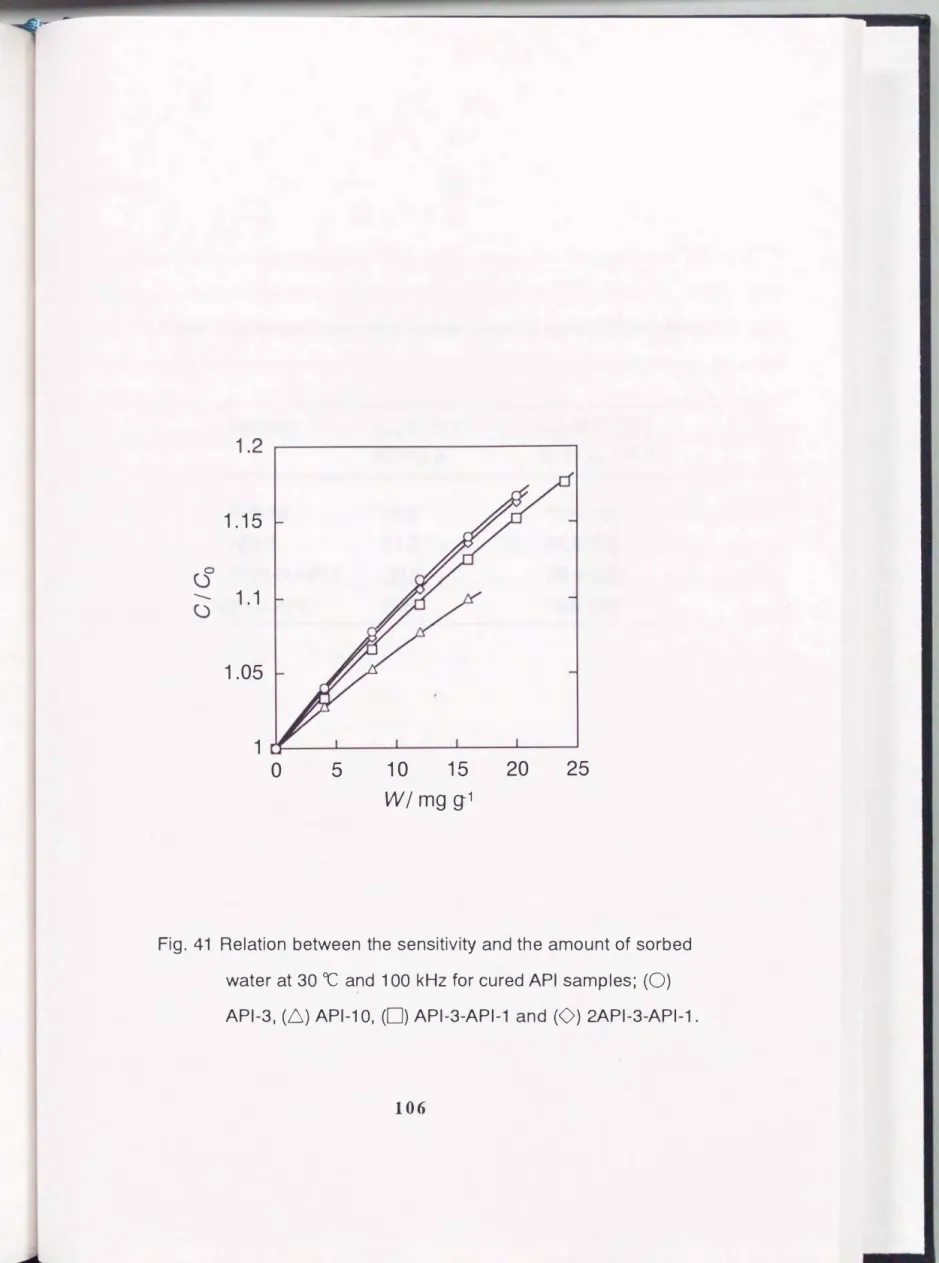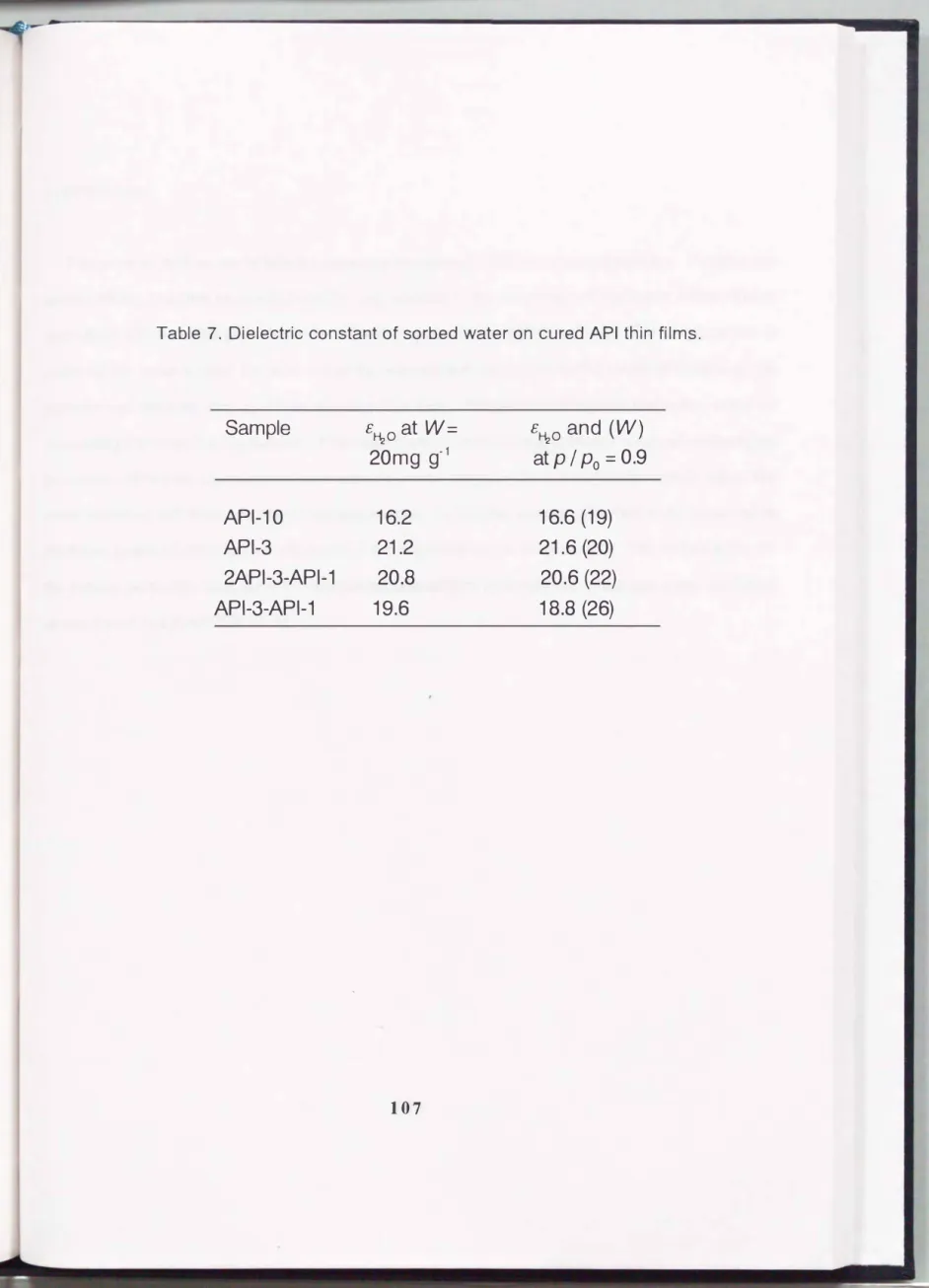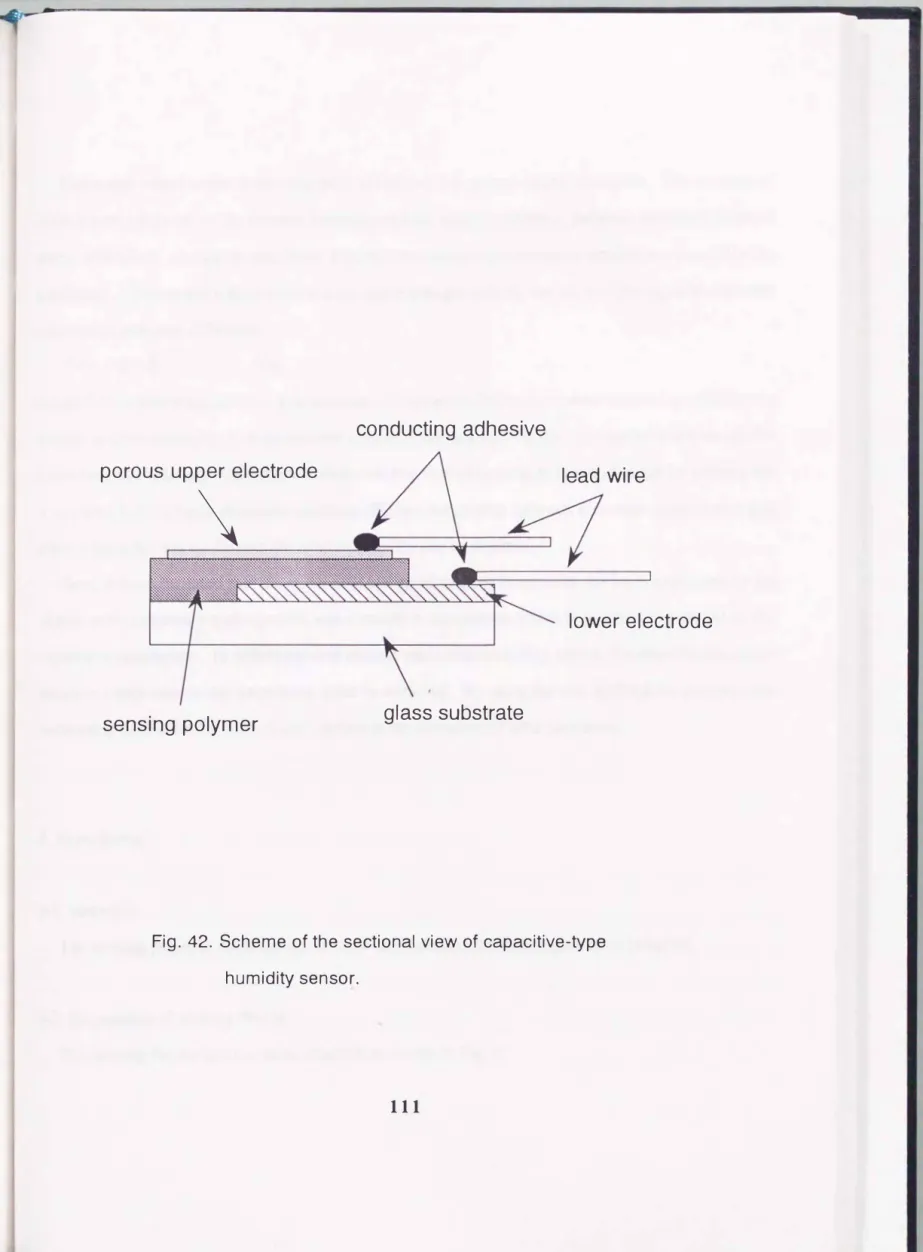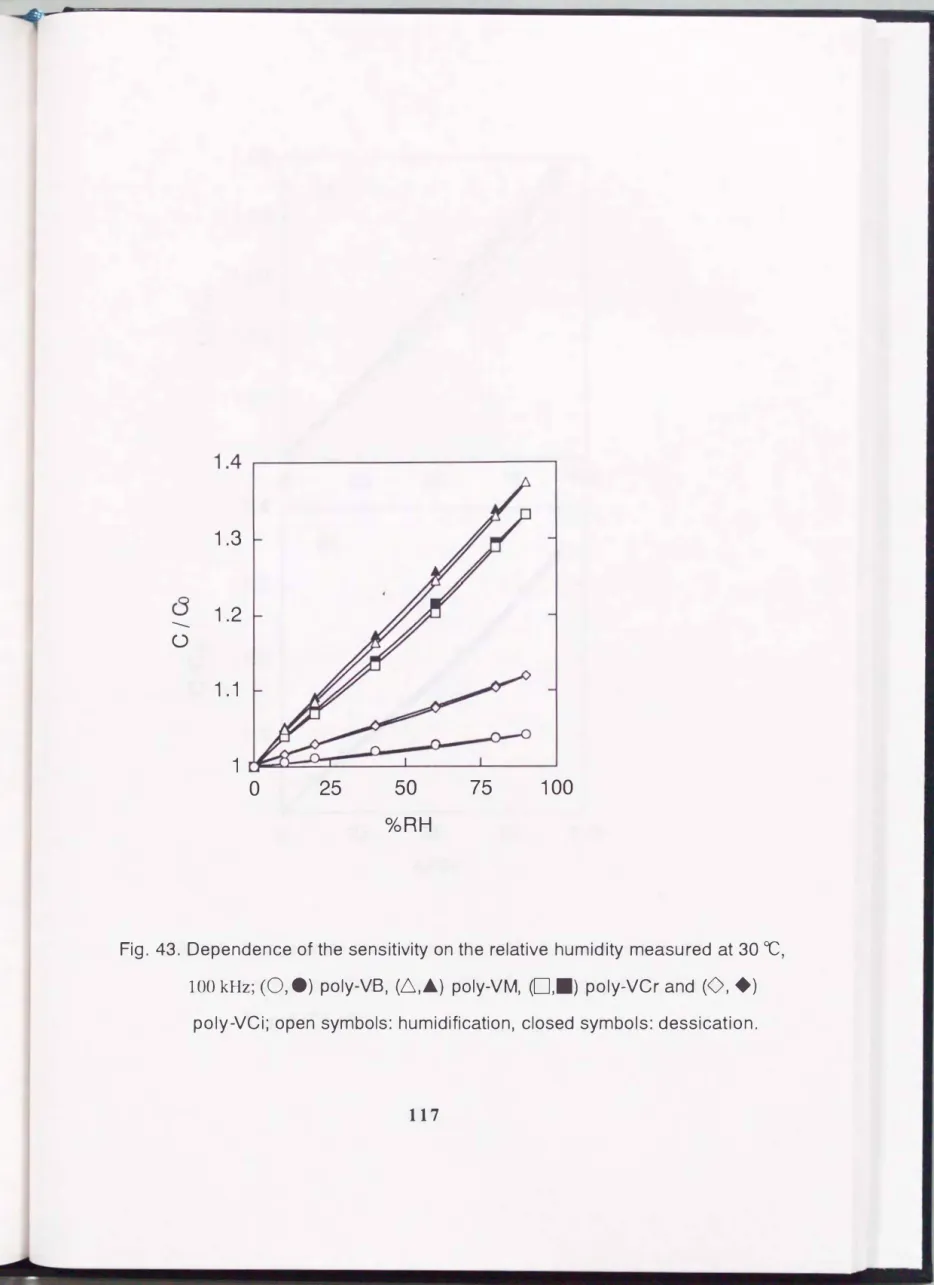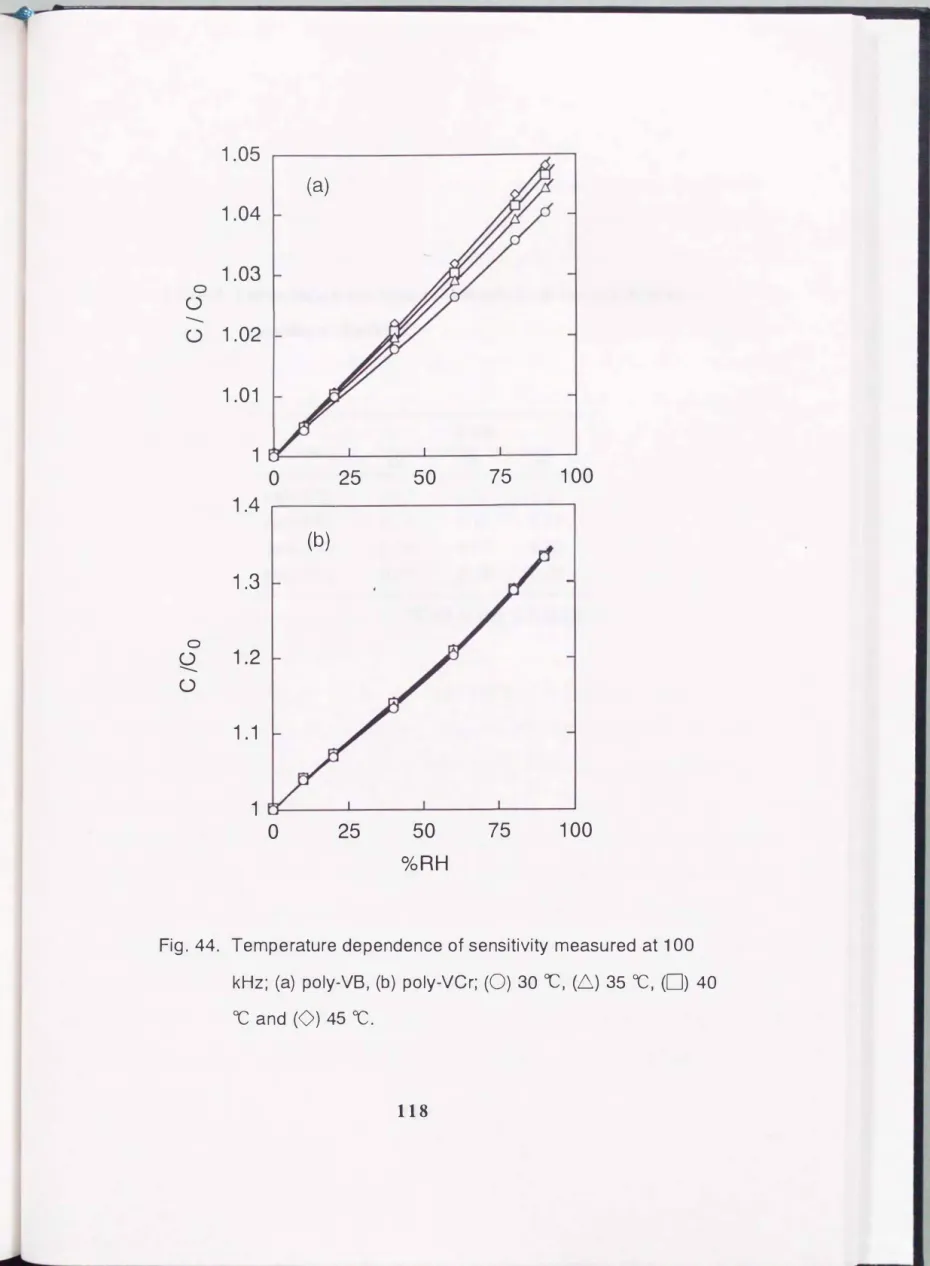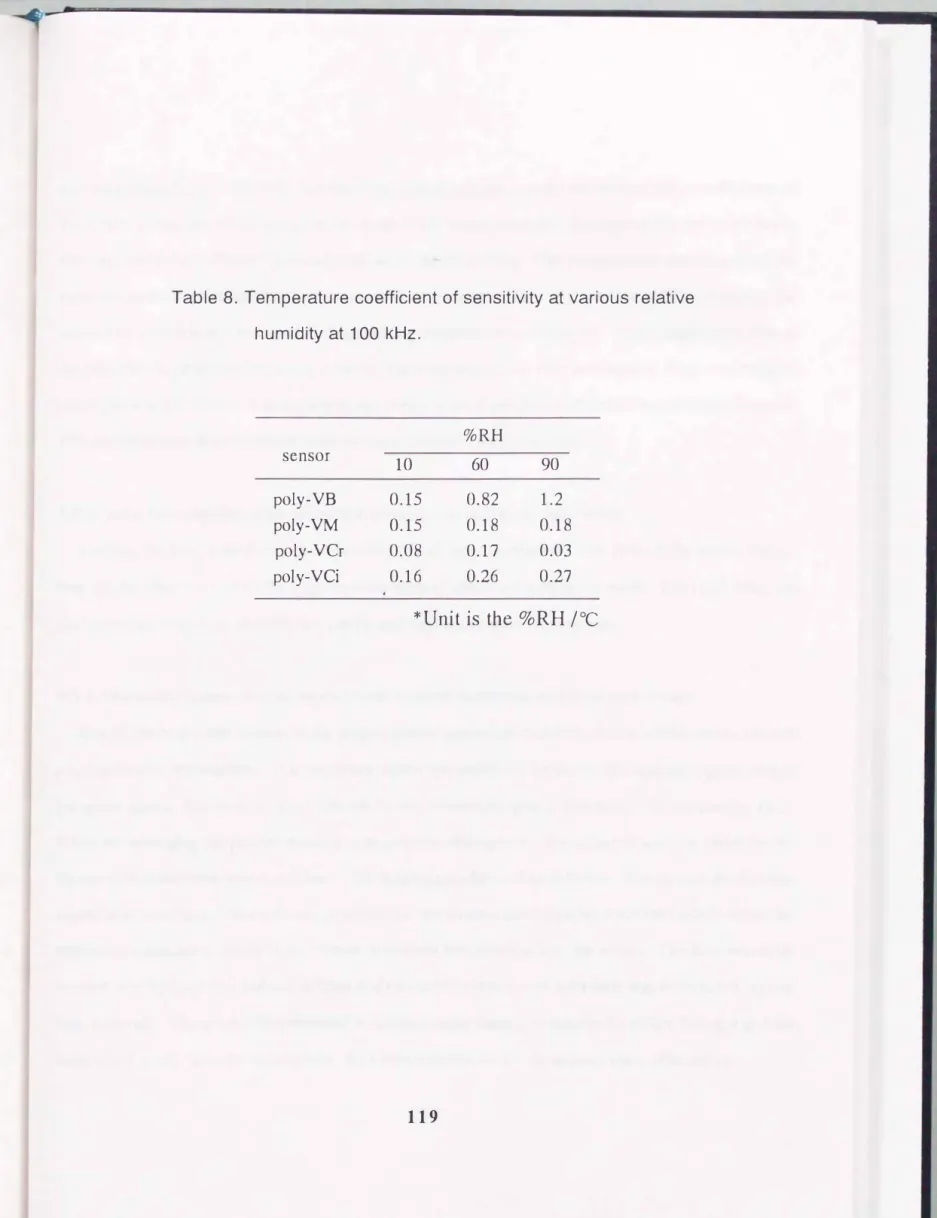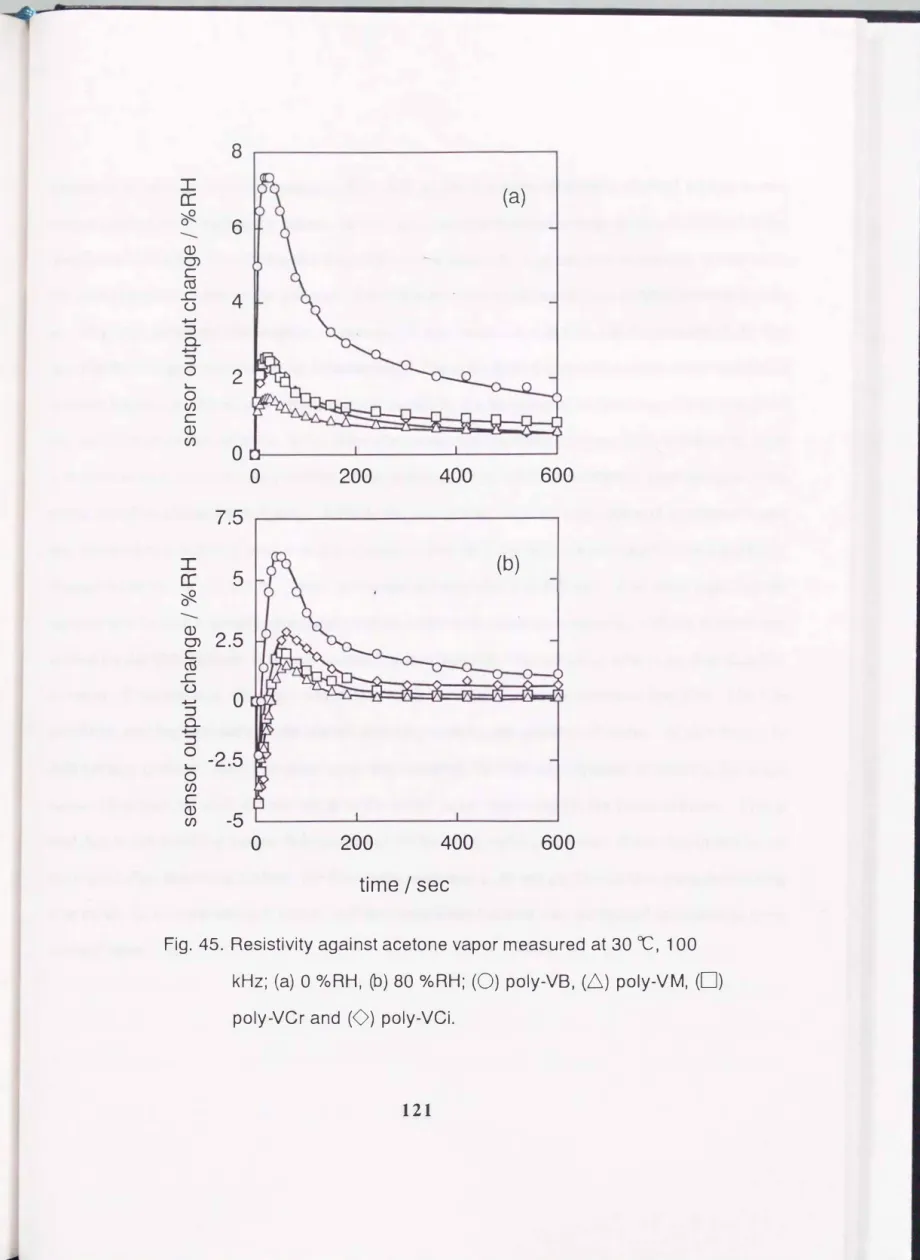九州大学学術情報リポジトリ
Kyushu University Institutional Repository
疎水性高分子への水収着挙動に関する研究とその湿 度センサへの応用
松口, 正信
1. Introduction
IV-III Effect of the cross-linking structure of polyimide resins on the water sorption behavior
As mentioned above, cross-linking has produced a marked increase in water sorption in copolymers
of methyl methacrylate with cross-linking agent or vinyl carboxylate. It seems interesting to examine whether the above phenomenon also observed on other polymers or not.
Since polyimides possess high workability, excellent thermal and chemical stability, low hygroscopicity, low solubility to common organic solvents, etc., they are used for adhesives, coatings, and film
applications for electronic devices. Recently new polyimide resins (acetylene-terminated polyisoimide oligomers) have been reported (53, 54). The new resins are preferable materials for examining the sorptio n behavior gravimetrically or dielectrically, since the starting materials are polyimide oligomers which are soluble in some organic solvents and polymerization proceeds without by-products. Further, each polyimide oligomer is cross-linked and leads to the formation of a rigid and hydrophobic film
without microvoids.
In this section, the effect of sorbed water on the dielectric properties of cured acetylene-terminated polyisoimide is examined and the state of sorbed water is discussed.
2. Experimental
2-1. Materials
Acetylene-terminated polyisoimide oligomers having three different types in molecular weights
were
used as starting materials. The abbreviations used are as follows: n=1, API-1; n=3, API-3;
n:::lO,
API-10. Acetylenic groups undergo cyclotrimerization and the three-dimensional crosslinked polyimide is formed by curing as shown in Fig. 38.
2-2.
Preparation of measuring device
The polyisoimide oligomer powder was dissolved in 2-methoxyethyl ether. Thin films were
formed
by spin coating on a glass substrate. The film was heated at 150 OC in nitrogen to remove the
solvent.
Curing proceeded under a nitrogen atmosphere at 180 OC for 1 h, 220 OC for 2 h, 260
ocfor
2 h, an
d 400 OC for 2 h, successively.
The rest of procedures for preparing device were mentioned in CHAPTER
III.2-3.
Measurement
The measuring method was mentioned precisely in CHAPTER III.
3.
Results and discussion
3-1.
Determination of curing condition
TG
measurements were carried out on the present oligomers from room temperature to 450 OC at a
heating
rate of 5 OC!min in flowing air and little weight loss was observed. This result proves that the
curing
proceeded without by-products. Further, good thermal stability was confirmed. Thermal
analysis was carried out on a DSC at 5 OC/min in flowing nitrogen. Two large exothermic peaks were
observed at
ca.220 OC and ca. 260 OC. Bott et al. reported that cross-linking readily occurs at
CH=C-of� Nw�
�� w
-N -o- � o-cr� 0-q� NWP �w-N-o-1
C=CHo 0
I � I -00 o
.o � .o no 0 �
I � I0 o
�n = 1, API-1; n = 3, API-3; n = 10, API-10
D
Fig. 38. Molecular structure of the acetylene-terminated polyisoimide oligomer and cross-linked polyimide.
260 OC for 2 h in nitrogen flow, DSC measurements also were performed. In this case, no peaks were
observed and the result suggests that this heat treatment is appropriate for reacting the terminal acetylene.
Further, we adopted the dielectric relaxation measurement to determine the curing condition in the film. It is well known that dielectric relaxation of a polymer arises from the segment motion of the main chain and side chain. If the cross-linking reaction proceeds and the film becomes rigid, the segment motion of the main chain seems to be depressed. Consequently the value of the dielectric loss is lowered. The dielectric loss ( £") vs. temperature relationships measured at 10kHz for uncured and cured API-3 and API-10 are shown in Fig. 39. Both uncured samples show a large peak in £" above 200 OC which corresponds to the segment motion. After heat treatment, the height of the peak decreased and the peak shifted to a higher temperature (above 2600C). The heat treatments were carried out under various conditions and the most suitable curing condition was 150 OC I 1 h, 180 OC I 1 h, 220 OC I 2.5 h, 260 OC I 2 h and 400 OC I 2 h in flowing nitrogen. Further, the shorter the oligomer chain length, the lower the value of£". This means that a rigid film is obtained using the oligomer with shorter chains. For API-1, many cracks were formed after curing and the device preparation was unsuccessful. We then tried to prepare a rigid composite thin film of API-3 and API -1. Thin films without cracks were formed when the ratio of API -1 to API -3 was less than 112 in weight. This is due to the good processability of API -3. The name of the API -3 and API -1 composite is abbreviated as follows: the ratio of API-3 and API-1 is 1; API-3-API-1 and 2; 2API-3-API-l. £"
was measured also for these samples. The height of the peak decreased and the peak shifted to a higher temperature by adding the API -1 to API -3; the rigidity of the film is enhanced by adding the short chain length polyisoimide oligomer.
3-2. Correlation between water sorption ability and dielectric behavior of the API thin films
1.5
.---.,(a)
1
w
0.5
0 L___::���==::t=:::::=--___L�d:u)
0 300
Fig. 39.
Temperature dependence of£" at
10
kHzfor uncured and
cured
APIsamples; (a) uncured
API-10, (b) cured
API-10,
(c) uncured
API-3and (d) cured
API-3.30
20
10
0
0 0.25 0.5
PI Po
0.75 1
Fig. 40.
Dependence of the amount of sorbed water on relative vapor
pressure at
300C;(e) uncured
API-3,(0) cured
API-3,hydrophobic than Kapton which is a representative polyimide as previously reported (12). The difference in the water sorption ability between the uncured and cured samples were observed. For the API-3 sample, the amount of sorbed water at p I p0 = 0.9 and 30 oc decreased by curing from 30.0 mg g-1 to 20.4 mg g-1. This seems to be conflict with the results obtained for cross-linked methacrylate
polymers mentioned above. The film thickness was measured with a surface-roughness meter before and after the curing treatment. The thickness was ca. 2 �m for uncured film and decreased ca.20 % after curing for all samples, i.e., the density of the polymer increased as a result of the polymerization.
One of the possible reasons is that the applicable spaces for water molecule diffusion and sorption
decreased. Consequently, the amount of sorbed water decreased due to curing. However, the free spaces, which are considered as sorption site is a molecular size in which the water molecule and polar site of polymer can interact. A water molecule may be encompassed by a sphere of diameter about 3
A,
small enough to fit into typical microvoids or spaces that comprise the structural free volume.Another possible reasons for decreasing sorption ability by curing is that the depression of swelling of the polymers. The rigid film must be formed by curing undoubtedly and resulted in the decrement of the amount of sorbed water. Among the cured samples, API-3-API-1 is the most hygroscopic one which sorbed 26.1 mg g-1 a t p I p0 = 0.9. The amount of sorbed water decreased in the order of 2API-3-API-1, API-3 and API-10, which sorbed 22.2, 20.4 and 18.9 mg g-1 of water, respectively as shown in Fig. 40. This order may be related to the polarity (affinity for water molecules) and the chain packing density of the polymer. The shorter the chain length of the oligomer, the number of carbonyl
groups per gram of polymer increases. The use of an oligomer with a shorter chain length results in an increase in polarity of the cured API film. Further, this behavior is also explained on the basis of the assumption that the sorption site is the free spaces around the polar sites of the polymer. Bondi ( 4) reported that the carbonyl group contributions to van der Waals volumes was estimated to be 3.2 times that of the ether group. This means that the shorter the chain length of the oligomer, the smaller the packing density, i.e., the free space for the sorption increase. In addition, it is expected that cross-linked
films prepared by polymerizing monomers with short chains seems to have highly strained chain conformations which prevent close chain packing. That leads to an increase in free spaces. These explanations arc consistent with the order of sorption ability of the cured APis. As for the present API system, there are many factors which seem to affect the sorption ability other than packing density.
The ratio of electrical capacitance at certain relative vapor pressure to that at p I p0 = 0 ( C I C0) decreased in the same order as that of the sorption ability. The relation between the
(
C I C0) and the amount of sorbed water is shown in Fig.41.
The ratio depend on not only the amount of sorbed water but also the API species. In order to discuss the state of sorbed water, the dielectric constant of the sorbed water was estimated by applying Kurosaki' s equation(14),
Eq. [1
0]. The value of3.5
wasused as the dielectric constant of the polymer. The volume fraction of sorbed water was calculated from the amount of sorbed water assuming that the density of all the cured API films is 1.68. The results are summarized in Table 7. It is well known that the dielectric constant of liquid water is 76.6
at 30 °C. The dielectric constant of the sorbed water for all measured samples is less than that of liquid water. As mentioned in CHAPTER IL the theoretical value of liquid water is
64
and that of single water molecule is3.19
at25
OC. Further, McCafferty et al. have reported(17-19)
that thedielectric constant of adsorbed water on a-F�03 had been about
2
for the first layer of physically adsorbed water and about 28 for the second layer. It seems that the sorbed water on the present samples does not form clusters and the mean self-association degree is less than two. Among the cured samples, the value of the dielectric constant of sorbed water is undoubtedly different for each cured API at a constant amount of sorbed water, i.e., the state of sorbed water is different. We must have a more detailed discussion to clarify the relation between the polarity and/or rigidity (packing density) of the polymer and the state of sorbed water. Some possible self associated forms had been proposed for the hydrogen bonded water(55).
The value of the dielectric constant of the intermolecular1.15
--- 1 . 1
1.05
1
0 5 10 15 20 25
W/mgg-1
Fig.
41Relation between the sensitivity and the amount of sorbed water at
30 ocand
1 00 kHzfor cured
APIsamples; (0)
API-3,
(6)
API-1 0,(0)
API-3-API-1and (0)
2API-3-API-1.Table 7. Dielectric constant of sorbed water on cured API thin films.
Sample
£�0at W=
£�0and (W) 20mg g-1 at pI Po= 0.9
API-10 16
.2 16.6 (19)
API-3 21.2 21.6 (20)
2API-3-API-1 20.8 20.6 (22)
API-3-API-1 19.6 18.8 (26)
4. Conclusion
The present API series is less hygroscopic compared with the other polyimides. Further the cross-linking reaction proceeded readily and resulted in the formation of rigid thin films. These properties affect the sorption behavior of water vapor on the API thin films. The sorption site is probably the space around the polar site of the polymer and sorption behavior seems to depend on the polarity and packing density of the polymer thin film. The amount of sorbed water decreased by proceeding the cross-linking reaction. This result seems in conflict with the result obtained methacrylate polymers. However, the space we now consider as the sorption site is a molecular size in which the water molecule and polar site of polymer can interact. In fact, the amount of sorbed water increased as the chain length of the oligomer shortened, i.e. the smaller the packing density. The sorbed water on the present polyimide docs not form clusters because of their hydrophobic nature and space limitation
as mentioned in CHAPTER VI-III.
CHAPTER V
Application of electrical characteristics of water sorbed thin film to a capacitive-type humidity sensor
1. Introduction
In recent years, there has been great interest in the development of humidity sensors for the air conditioning systems or industrial equipment, etc. Many types of material, such as porous oxide (56-58) and polymers (59-65) have been proposed for humidity sensors. Humidity sensors using polymer thin films arc divided into two categories, i.e. the resistive and capacitive types. For the former, conductivity is enhanced by the sorption of water and by the dissociation of mobile carriers.
Consequently, the polyelectrolytes are excellent materials for resistive-type humidity sensors, because their electrical conductivity varies when they sorb moisture. However, since most polyelectrolytes are soluble in water, they are unstable at high humidity. There has been an effort to improve their resistivity to water (59-61). For the latter, the capacitance is enhanced by the sorption of water and the impedance is approximately 1/wC. Polyimide, polyvinyl alcohol and/or cellulose derivatives had been used for materials of this type of sensor. While the variation of capacitance for cellulose with humidity is lower than that of the resistance for porous oxide, it seems that the capacitive-type sensor is superior in stability to the resistive-type sensor. However, many problems, i.e., hysteresis, stability in high temperature and humid atmosphere and durability for some kinds of organic vapor, etc., still remain for practical use.
In the present CHAPTER, the application of water sorption behavior of polymer to the capacitive-type humidity sensor is discussed.
2. Principle of capacitive-type humidity sensor
The basic scheme of the sectional view of capacitive-type humidity sensor is shown in Fig. 42. It
can be sh0\\'11 that the sensing polymer is sandwiched by porous upper electrode and lower electrode.
conducting adhesive
porous upper electrode lead wire
\
lower electrode
sensing polymer glass substrate
Fig.
42.Scheme of the sectional view of capacitive-type
humidity sensor.
The water vapor sorbs in sensing polymer across the porous upper electrode. The amount of sorbed water depend on the relative humidity and the characteristics of polymer as shown in these series of studies. As can be seen from Fig. 42, this sensor have structure similar to a parallel-plate condenser. Consequently, the electrical capacitance changes with the variation of the apparent dielectric constant of polymer as follows
C = k c (S I l) [24],
where Cis electrical capacitance, k is constant, f is apparent dielectric constant of sensing polymer at a certain relative humidity, S is the surface area of electrode and l is the distance between electrodes (thickness of polymer). The apparent dielectric constant of sensing polymer changes by sorbing the water which have large dielectric constant. If the relationship between electrical capacitance and relative humidity are confirmed, the relative humidity can be detected.
Here, it must be noted that the equivalent circuit of this condenser-like device is expressed by the circuit with a capacitive component and a resistive component which is inserted in parallel to the capacitive component. In order to obtain reliable and stable humidity sensor, the contribution of the resistive component to the impedance must be removed. By using the less hydrophilic polymer, the conducting path is hardly formed and resulted in the formation of ideal condenser.
3. Experiment
3-1. Materials
The sensing polymer materials are as same as those used for studying sorption behavior.
3-2. Preparation of sensing device
The sensing device had the same structure as shown in Fig. 4.
3-3. Measurement
To examine the effect of the humidity on the electrical properties, the sensing devices were placed in a vessel in which the humidity was controlled by mixing dry air and w et air, followed by measurement of the electrical capacitance using a LCZ meter at 100 kHz.
4. Results and discussion
4-1. Capacitive-type humidity sensor using cellulose derivatives
As the capacitive-type of sensor, it had been well known that cellulose derivatives such as cellulose acetate butyrate (CAB) was suitable material. However, the large hysteresis was confirmed as shown in CHAPTER IV-I, 3-1. This was originated from the formation of the clusters of sorbed water molecule. Further, the durability against various organic vapor and the long term stability are not desired. Consequently, capacitive-type humidity sensor using cellulose derivatives is unsatisfied for practical use.
4-2. Capacitive -type humidity sensor using PMMA and cross-linked PMMA film
4-2-1. Initial sensing properties of cross-linked PMMA sensor
Though the change of electrical capacitance of cross-linked PMMA (Fig. 32) to relative humidity was smaller than that of the cellulose derivatives (Fig. 15) because of its lower hygroscopicity, it was enough to detect a humidity change. Furthermore this sensor had good linearity over the humidity range of 10-90 %RH. The response was very fast (the 90 %RH response time was within 30 s by
4-2-2. Temperature coefficient of PMMA and cross-linked PMMA sensor
The temperature dependence of PMMA sensitivity was examined. It was observed that this sensor had a positive temperature coefficient. This temperature dependence was shown to arise from the temperature dependence of PMMA permittivity itself. It is well known that PMMA showed a dielectric relaxation peak at ca. 340 K at 1 kHz due to the side-chain motion.
The temperature dependence of sensitivity for the cross-linked PMMA sensor was also examined.
The C45/C30 (capacitance at 45 oc and 30 °C, respectively) ratios at 0 %RH for the film cross-linked at 90 oc was not improved except for DVB and the temperature coefficient of sensitivity ( C4.JC30 at 90
%RH - C45/C30 at 0 %RH) was also not improved. This is due to the segment motion of PMMA having insufficient cross-linking. On the other hand, when the PMMA was cross-linked at higher temperatures up to 170 °C, temperature dependence both at 0 %RH and 90 %RH became small and the temperature coefficient became smaller than PMMA itself. This is due to the depression of segment motion and/or swelling of the polymer by sufficient cross-linking.
4-2-3. Durability against acetone vapor of PMMA and cross-linked PMMA sensor
The durability of this PMMA sensor towards acetone vapor was tested since acetone is a good organic solvent for PMMA This test was performed as follows. After exposure to saturated acetone vapor for 20 min in a closed container, the sensor was quickly transferred to the vessel in which the humidity and temperature were controlled. The sensitivity at various humidities was measured repeatedly for three cycles. The term cycle refers to the process where the humidity was changed from 0 %RH to 90 %RH followed by reduction from 90 %RH back to 0 %RH. The capacitance value immediately after exposure to acetone vapor was large and this was due to the sorbing of acetone. The increments of 5 % of capacitance at 0 %RH and 8 % at 90 %RH were observed upon exposure to acetone. After repeating the measurements three times, the increments of capacitance decreased to 0.7 % at 0 %RH and 5 % at 90 %RH as the acetone was desorbed. However, the value did not return to its original
value. In order to prepare a practical humidity sensor, it is necessary to minimize the influence of acetone on the characteristics of the sensor
Furthermore, we examined the durability of the cross-linked PMMA sensors against acetone vapor.
The cross-linked sensor with ED reacted at 90 "C was also unstable like PMMA itself and the value of the capacitance at a constant humidity was increased by the exposure to acetone and then decreased with increasing measuring cycle. On the other hand, the sensor cross-linked at 170 "C was quite stable, showing little effect by acetone vapor and almost recovered to the original value after 3 cycles of measurements. The increments of capacitance immediately after exposure to acetone were 1 % at 0
%RH and 1.6 % at 90 %RH and those after 3 cycles measurements were 0.3 % at 0 %RH and 1% at 90 %RH. This means that the cross-linked PMMA film simply sorbed acetone without permanent deformation. This result was explained as follows. When the PMMA was cross-linked at 90 "C, the cross-linking was insufficient as previously. mentioned and the acetone was easy to diffuse into the bulk and difficult to desorb. Further, partial dissolution of the PMMA film was also possible.
Consequently, the value of capacitance drifted. As the cross-linking proceeded and the film stiffened, the sorption of acetone would be limited to the surface and/or film/electrode interfaces. To confirm this interpretation, we measured the amount of sorbed acetone by gravimetrically method. The amount of sorbed acetone for the sample cross-linked at 170 "C (15 mg/g) was reduced to one-half that of the sample cross-linked at 90 °C.
4-2-4. Long term stability of cross-linked PMMA sensor
We have also examined long term stability under various conditions, e.g. high temperature and high humidity, various paint vapors and tobacco smoke, etc. Excellent stability was exhibited in the environments, excluding that with tobacco smoke, showing less than + 2 %RH drift after the tests,
4-3. Capacitive-type humidity sensor using polymerized carboxylic acid vinyl esters
4-3-1. Initial sensing characteristics of polymerized carboxylic acid vinyl esters sensor
The electrical capacitance of the present sensors was measured as a function of relative humidity at 100kHz as shown in Fig. 43. The capacitance increased linearly with relative humidity. These sensors had small sensitivity (capacitance at 90 %RH I capacitance at 0 %RH ratio) and the sensitivity depended on the polymer species. This is derived from the enhancement of the water content with an increase in the cross-linking degree. The sensitivity was reproducible. The present film was cross-linked by itself with heat-treatment on the substrate and this simple process reflected the reproducibility of the sensor. These are favorable characteristics for humidity sensors. The increment of sensitivity tends toward the increment of hysteresis. The cause of hysteresis is considered as the formation of clusters of sorbed water. For poly- VM sensors, the hysteresis was strongly affected by the history of exposure to a humid atmosphere similar to Fig. 11. While no distinct differences of sensitivity in the humidification processes starting from 0 %RH were confinned, the sensitivity observed in the desiccation process increases with an increase in the highest humidity of exposure. This result shows that the formation of clusters of sorbed water was initiated by increasing the water contents at a higher relative humidity region and desorption became difficult in the desiccation process. However, the hysteresis was small, within 2 %RH, including experimental error even for the cross-linked sensor.
4-3-2. Temperature coefficient of the polymerized carboxylic acid vinyl ester sensor
The temperature dependence of the sensing characteristics was examined and the results obtained for poly-VM and poly-VCr are shown in Fig. 44. The electrical capacitance increased with increasing temperature and also with increasing relative humidity. For the poly- VCr sensor, the temperature coefficients of the sensor output are small compared to those of poly-VB. The temperature coefficients for all samples at several relative humidities were estimated as the relative humidity change per degree
1.3
---
1.2
01.1
1
0 25 50 75 100
o/oRH
Fig. 43. Dependence of the sensitivity on the relative humidity measured at 30
OC,
100kHz;(0, e)
poly-VB,(6,�)
poly-VM,(0,.)
poly-VCr and(0, +)
1.05
1.04
1.03
0
0
---
0
1.02 1.01
1 1.4
1.3
0
0
1.2
---
0
1.1
1
(a)
0 25
(b)
0 25
50
50 o/oRH
75
75
100
100
Fig. 44. Temperature dependence of sensitivity measured at 100 kHz; (a) poly-VB, (b) poly-VCr; (0) 30 oc, (6) 35 OC, (0) 40
OC and (0) 45 OC.
Table
8.Temperature coefficient of sensitivity at various relative humidity at
1 00 kHz.%RH sensor
10 60 90
poly-VB 0.15 0.82 1.2 poly-VM 0.15 0.18 0.18
poly-VCr 0.08 0.17 0.03 poly-VCi 0.16 0.26 0.27
*Unit is the %RH ;oc
and are summarized in Table 8. For the cross-linked polymer sensor, the temperature coefficients of the sensor output are small compared to those of the linear polymer. The reason for the reduction in the temperature coefficient is considered to be the following. The temperature coefficient of the capacitance is closely related to the temperature coefficient of the water sorption ability. Actually, the amount of sorbed water increased with increasing temperature in this study. As the segment motion of the polymer is depressed by cross-linking, the swelling of the film in a humid, high temperature atmosphere is prevented. Consequently, the temperature dependence of sorbed water becomes small.
This consideration was consistent with the experimental results obtained.
4-3-3. Long term stability of the polymerized carboxylic acid vinyl ester sensor
Further, we have tested long-term stability in ambient atmosphere. The drift of the sensor output was hardly observed within the experimental error to date for 6 months or more. The rigid structure also promises long-term stability in a humid and high temperature atmosphere.
4-3-4. Durability against acetone vapor of polymerized carboxylic acid vinyl ester sensor
One of the important objects is the preparation of a practical humidity sensor which can be used in a contaminated atmosphere. It is necessary to test the resistivity of the sensor against organic and/or inorganic gases. Acetone is a good solvent for the monomers used in this study. Consequently, there is fear of damaging the present sensors in an acetone atmosphere. The effect of acetone vapor on the sensor characteristics was examined. The test was performed as follows. The sensor device was seated in a vessel (ca. 5 liter volume) in which the temperature and humidity were controlled. After the capacitance reached a steady state, 500 ml of acetone was injected into the vessel. The time when the acetone was injected was defined as zero, and the capacitance change with time was recorded at regular time intervals. The results are converted to sensor output change in relative humidity changes and are shown in Fig. 45. In a dry atmosphere, the characteristics for all the sensors were affected by
8
I
(a)
a:
'#-
----
6
0) Q) c ro ..c (.)
4
+-' :J
+-' a..
:J 0
lo....
2
0 (/) c Q)
(/)
0
0 200 400 600
7.5
I
(b)
a:
5
'#-
----
Q)
2.5
0) c ..c ro
(.)
0
+-' :J
+-' a..
�
:J-2.5
0 (/) c Q)
-5
(/)
0 200 400 600
time I sec
Fig.
45.Resistivity against acetone vapor measured at
30OC,
100 kHz;(a)
0°/oRH, (b)
80o/oRH; (0) poly-VB, (6) poly-VM, (0)
exposure to acetone vapor. Especially, Poly-VB, which is a linear polymer, showed a large sensor output change compared to the others. In this case, the sensor output change is directly related to the sorption of acetone. This means that poly-VB sorbs a relatively large amount of acetone in relation to the water sorption ability of the polymer. The linear polymer swells readily by sorbing acetone and the swelling may accelerate the sorption of acetone. Once the polymer swells, the dimensions of the film seem to be changed and can hardly be recovered. The cross-linked polymer sensors were resistive to acetone vapor, i.e., the sensor output change caused by the sorption of acetone vapor was small and the output nearly returned to the initial value after removing the acetone vapor. This is due to the rigid structure which prevents the swelling of the polymer. The effect of acetone vapor became more complicated in a humid atmosphere. Initially the capacitance decreased by exposure to acetone vapor and resulted in a negative sensor output change. After that, the drift became positive and gradually recovered to the initial value. These processes are explained as follows. Just after injecting the acetone at a certain humidity, previously sorbed water molecules were expelled and the acetone was sorbed on the film instead. It is well known that the dielectric constant of acetone is smaller than that of water. Consequently, the capacitance decreased. Acetone can easily penetrate into film. The film swells by sorbing acetone and the sorbed acetone promotes the sorption of water. At this stage, the drift became positive. As the acetone vapor was removed, the drift was expected to return to the initial value. However, the drift did not return to the initial value, especially for the linear polymer. This is also due to the swelling and/or deformation of polymer by sorbing acetone. If the dimension is not recovered after removing acetone, the film sorbs more water. It was confirmed that cross-linked film was stable in its own solvent vapor, and the cross-linked sensor can withstand exposure to most contaminants.
4-4. Capacitive-type humidity sensor using acetylene-terminated polyimide resins
4-4-1. Initial sensing characteristics of the cross-linked polyimide sensor
In the case of the uncured sample, hysteresis was obseiVed between the capacitance when measured with increasing humidity and the one when measured with decreasing humidity. On the other hand, hysteresis was not detected for the cured films. This is due to the fact that the amount of sorbed water is small and the swelling of the polymer and the formation of clusters of sorbed water are prevented when using the cured sample. Capillary condensation is not needed to consider as the cause of hysteresis because the hysteresis becomes smaller after curing. The space we consider is not the geometrical pores but the molecular sized microvoids. Further the electrical capacitance changed linearly with relative humidity. These are the preferable characteristics of a humidity sensor. Among the prepared sensors, the sensitivity (capacitance at 90 %R H I capacitance at 0 %RH ratio) of the API-3-API-1 sensor was the largest(l.184) and decreased in the order of 2API-3-API-1(1.176), API-3(1.171) and API-10(1.116).
4-4-2. Temperature coefficient of the cross-linked polyimide sensor
The temperature coefficient of the sensor was examined. For the uncured sample, a large temperature coefficient was observed. At 0 %RH, the value of electrical capacitance slightly decreased with increasing temperature. This is due to the segment motion of the API. However, above 10
%RH, the electrical capacitance increased with increasing temperature and also with increasing relative humidity (the temperature coefficient is +0.3 %RH/°C at 40 %RH and +0.5%RHtC at 80 %RH in the temperature range from 30 oc to 45 oc ). This is derived from the temperature coefficient of the amount of sorbed water, i.e., the amount of sorbed water increased from 29 mg!g to 49 mg!g with
segment motion of the API is depressed by cross-linking, and ( ii) the rigid structure leads to a reduction in the sorption sites (the space around the polar group) and results in a decrease in the temperature coefficient of the amount of sorbed water.
4-4-3. Durability against acetone vapor of the cross-linked polyimide sensor
The effect of acetone vapor as a prototype of polar organic vapor on the sensor characteristics was examined. The test is performed as mentioned in section 4-3-4. The capacitance of both the uncured and cured sample was not affected by the acetone vapor in a dry atmosphere, while the capacitance was affected by the acetone vapor in a humid atmospheres. This means that the cured polyimide does not sorb the acetone vapor. In the humid atmosphere, the sorbed water accelerate the diffusion of acetone vapor. However, the capacitance drift recovered to its initial value. For the sensors stored at 40 OC and 90 %RH, the sensitivity at 30 OC was examined as a function of the storage periods at 40 OC and 90 %RH. The sensitivity drifted within the initial100 h and approached a constant value after 1000 h, the drift of the API-3 sensor output was +6 %RH. The value was very small compared with other polyimide sensors and the stability in the high temperatures and in humid atmospheres was improved.
The present polyimide w a s polyimidized before coating and cured on the substrate by simply reacting the acetylene group. This good workability reflected the reproducibility of the sensor. The sensor characteristics was reproducible and calibration of each sensor was not needed. Further, we have tested the long term stability in the ambient atmosphere. The drift of the sensor output was within 2 %RH even after the sensor was allowed to stand for at least 17 months. Consequently, preparation of the reliable capacitive type humidity sensor was achieved by using the acetylene-terminated polyimide resins.
5. Conclusion
It was proved that the important requirements for fabricating capacitive-type humidity sensors were low hygroscopicity and the rigid structure of the sensing polymer. The formation of clusters of sorbed water molecules caused the hysteresis. The swelling and/or deformation of the film caused the large temperature coefficient and lack of long-term stability. Cross-linking technique was effective for improving those problems. Polymethyl methacrylate, which had a carbonyl group as the polar site, was a suitable material for a humidity sensor because of its low hygroscopicity. The influence of some organic vapor on the sensing characteristics was depressed by the use of cross-linked PMMA instead of linear PMMA. The temperature coefficient and long-term stability were also improved by using the cross-linking technique. On the other hand, the mixing of methyl methacrylate (MMA) with a cross-linking agent was liable to induce phase separation and lead to an incomplete cross-linking reaction.
In stead of linear methacrylate, the unsaturated vinyl carboxylate, which was cross-linked by itself, was suggested. The sensitivity was enhanced by cross-linking the polymer because of the increase in the free space around the polar site, which acted as the sorption site. The sensitivity was higher than that of cross-linked PMMA sensor and equivalent to that of C AB sensor. Although larger amounts of sorbed water usually caused the hysteresis, the hysteresis was very small for the present cross-linked sensor, less than 2 %RH including experimental error. The temperature coefficient was lowered by using the cross-linked vinyl carboxylate. This is due to the depression of segment motion. It is obvious that CAB and linear PMMA are unstable in the organic vapor, since these polymers are soluble in organic solvents. Although the capacitance of all present sensors was affected by exposure to acetone vapor, the output was recovered to the initial value after removing the acetone vapor, especially for the cross-linked sensor. The formation of a tight network is also expected to improve
In the case of API sensor, the sensing characteristics depended on the kind of API oligomer used.
Among the present API series, the API-3-API-1 was superior with respect to sensitivity and durability against acetone vapor. This may be due to its very rigid structure. The effectiveness of the cross-linked structure for sensing material as a capacitive-type humidity sensor was also confirmed.
We believed that the less hygroscopic polymer with a rigid structure shows promise as a reliable humidity sensors.
CHAPTER VI
SUMMARY
Sorption behavior in some hydrophobic polymers were investigated. In the case of a hydrophilic polymer, the major factor, which affects water sorption ability, seems to be the hydrophilicity of the constituent group of the polymer and their density in the film. However, it is expected that many factors affect the water sorption behavior of a hydrophobic polymer. The object of this study was understanding the origins of the differences in the water sorption behavior of a hydrophobic polymer.
The sorption behavior of water on various hydrophobic polymers, which have different chemical structure and morphology, was investigated by sorption analysis, dielectric measurement and solvatochromic measurement. As a result of the present study, the following facts were clarified.
In order to clarify the effect of the polar substituent groups of polymers on the sorption behavior, cellulose derivatives were chosen for polymers because of their common rigid structural unit with different polar groups. Cellulose has up to three ester and/or ether groups per glucose monomer.
Consequently, their hydrophilic centers, to which water hydrogen bonds, are ester, ether and a few gluconic acid groups. Three different techniques for predicting and explaining the sorption behavior of the cellulose were used.
There were at least two dominant modes of sorption of water in cellulose film. The first mode occurred at lower content of sorbed water and it corresponded to the interaction of the water molecules with the polar hydroxyl, carbonyl and/or ether groups. When the specific sites are saturated, additional sorbed molecules of water tended to associate to form clusters. However, the size of the cluster estimated from dielectric measurement was small, on the average less than two water molecules associated. Among cellulose derivatives, ethyl cellulose (Eq had a higher tendency to form clusters.
The solvatochromic measurement revealed the information on the interaction between the polymer and sorbed water. It was observed that only EC was characterized by a low polarity
I
polarizability and a high hydrogen-bond basicity. It is suggested that the sorbed water molecule in EC acted as a strong hydrogen bond acceptor. This behavior seems to be derived from the ether oxygen in EC. Further, sovatochromic parameterf3
, hydrogen bond basicity, was effective for predicting the formation ofwater molecule clusters.
The morphology is another factor which affects the water sorption behavior of less hydrophilic polymers as well as the hydrophilicity of the polymer. The difference between the linear polymers and the cross-linked polymers are molecular packing, that is, the size of the free space around the polar site of the polymer. The effect of the degree of cross-linking and the chemical structure on the sorption behavior were discussed.
Cross-linked polymers, which have a carbonyl group as the polar site, were chosen for this purpose. Cross-linked networks by copolymerizing methyl methacrylate enhanced the sorption ability and the sorption ability depended on the cross-linking condition as well as the cross-linking agent.
The sorption ability of the cross-linked polymer without using a cross-linking agent was also examined.
It was also confirmed that the polymer with a highly cross-linked structure had a larger amount of water content. Consequently, the enhancement of water sorption ability by forming a cross-linked structure was attributable to the increase in the free space in molecular size around a polar site derived from the highly strained chain conformation. While it was proven by sorption analysis that methacrylate polymers had a greater tendency to cluster formation of water, the sorbed water molecules scarcely formed clusters. This could be explained because of their hydrophobic property and space limitation of the polymer.
The effect of cross-linked structure on the water sorption ability was also examined for polyimide resins (acetylene-terminated polyisoimide oligomers). In order to change the packing density of the polymer, a polyisoimide oligomer with different chain length were used.
The amount of sorbed water decreased by proceeding the cross-linking reaction. However, the amount of sorbed water increased as the chain length of the oligomer shortened. In other words, the smaller the packing density, the larger the sorption ability.
less hygroscopic methacrylate polymers, which had a carbonyl group as the polar site, was proven to be a suitable material for a capacitive-type humidity sensor. The sensitivity was enhanced by cross-linking the methacrylate polymers without arising the hysteresis. Further, the cross-linking technique was effective for preventing the temperature coefficient and lack of long-term stability of a sensor by depressing the swelling and/or deformation of the film. The unsaturated vinyl carboxylate or acetylene
terminated polyimide were cross-linked by itself with heat treatment. Capacitive-type humidity sensors using these less hygroscopic and cross-linkable polymer were found to be suitable for practical and reliable use.
ACKNOWLEDGMENT
The author wishes to offer special thanks to Professor l(jnshi Motomura of Kyushu University, Fukuoka, for his kind and helpful advices in completing the present research.
The author also expresses cordial thanks to Professor Yoshiro Sakai and Dr. Yoshihiko Sadaoka of Ehime University, Ehime, for their helpful discussions and their constant encouragement throughout the course of the present investigation.
The author would like to thank Dr. Makoto Aratono o f Kyusyu University, Fukuoka, and Dr.
Norihiro Ikeda of Fukuoka woman's University, Fukuoka, for their kind assistance in the preparation of the manuscript.
Finally, thanks are given to all the graduates and the members of Sakai Laboratory of Ehime University, Erume, for their much help in the experiment throughout this work.
REFERENCES
(1) L. Pauling, J. Amer. Che1n Soc.,
6
7, 555 (1945).(2) M Dole and I. L. Faller,]. Amer. Chem Soc., 7
2,
414 (1950)).(3) F. J. Bueche, J. Polym Sci.,
14,
414 (1954).(4) A. Bondi, J.Phys.Chem.,
68(3),
441 (1964).(5) V. A. Kargin,J.Polym.Sci.,
23,
47 (1957).(6) D. T. Turner, Polymer, 2
8(2)
, 293 (1987).(7) M Atsuta, T. Hirasawa and E. Masahara, J. Jpn. Soc. Dental Apparatus Materials,
10,
52 (1969).(8) J.M. Barton, Polymer,
20(8),
1018 (1979).(9) D.T.Turner and A.K.Abell, Polymer,
2 8,
297 (1987).(10) M. E. Best and C. R. Moylan, J. AppL Poly1n Sci.,
4
5, 17 (1992).(11)S.
Kalachandra and R. P. Kusy, Polymer,32(13),
2428 (1991).(12) C. R. Moylan, M. E. Best and M. Rec, J. Polym Sci., Polymer Phys., 2
9,
87 (1991).(13) G. lnzelt, P . Jed lovszky, K. Marinusz and P. Hudaky, Acta Chimica Hungarica,
128 (6),
797 (1991).(14)
S.
Kurosak�
J.Phys. Chern., 58, 320 (1954).(15) J . M . Thorp, Trans. Faraday Soc., 55, 442 (1959).
(16) M.G. Bald win and 1. C. Morrow, J.Chem.Phys.,
36(6),
1591 (1962).(17) E. McCafferty, V. Pravdic and A. C. Zettlemoyer, Trans.Faraday Soc.,
6 6,
1720 (1970).(18) E. McCafferty and A. C. Zettlemoyer, Trans.Faraday Soc.,
6 6,
1732 (1970).(19) E. McCafferty and A. C. Zettlemoyer, Diss.Faraday Soc., 5 2, 239 (1970).
(20) E. M. Kosower, J. Am. Chem Soc.,
8 0,
3253 (1958).(21) C. Reichardt, Angew. Chem internat Edit.,
4 ( 1 )
, 29 (1965).(24)
M. J. Kamlct, J. L. Abboud and R. W. Taf� J. Am. Chem Soc., 99(18),6027 (1977).
(25)
C. Reichardt, Chem Soc. Rev., 2 1,147 (1992).
(26)
M.S. Paley, R. A. McGill, S .C. Howard, S . E. Wallace and J . M. Harris, Macromolecules, 23,4557 (1990).
(27)
R. M. McGill, M S. Paley and J. M. Harris, Macromolecules, 25 ( 1 2 ),3015 (1992).
(28)
P. M. W iggins, Pro g. Poly1n ScL,, 1 (1988).
(29)
S. Brunauer, L. S. Deming, W. E. Deming and E. Teller, f. Am. Che1n Soc., 6 2 ,1723 (1940).
(30)
I. Langmuir, J. Am. Chem Soc., 40,1361 (1918).
(31)
S. Brunauere, P. H. Emmett and E. Teller, f. Am. Chem Soc., 60,309 (1938).
(32)
G. L. Brown, in Water in Polymers; S. P. Rowland, Ed.; American Chemical Society: Washington, D. C.,1980; p.441.
(33)
K. Kawasaki andY. Sekita, J. Appl. Phys. J apan, 2 6,678 (1957).
(34)
F. Bueche, J. Polym Sci., 14,414 (1954).
(35)
B. H. Zimm, J. ChemPhys., 2 1,934 (1953).
(36)
B. H. Zimm and J. L. Lundberg, J. Phys. Chem.,, 6 0,425 (1956).
(37)
R. M. Barrer, J. A. Barrie and J. Slater, J. Polym Sci., 23,315 (1957).
(38)
P. M eares, Trans. Faraday Soc., 54,40 (1958).
(39)
A. S. M ichaels, W. R. Vieth and J. Barrie, J. AppL Phys., 3 4,1
and13 (1963).
( 40)
N. E. Hill, W. E. Vaughan, A. H. Price and M. Davies, in Dielectric Properties and Molecular Behaviour, Van Nostrand Reinhold, L ondon,1969;
P.13.
(41)
L. G. S. Brooker, G. H. Keyes and D. W. Hcseltinc, J. Am. Chem Soc.,73,5350 (1951).
( 42)
G. S. Sauerbrey, z. Phys., 15 5,206 (1959).
( 43)
G. S. Sauerbrey, Z. Phys., 17 8,457 _(1964).
(44)
D. K. Beever and L. Valentine,]. AppL Che1n, 8( 2 ),103 (1958).
(45)R.
M. Barrcr andJ. A. Barrie,]. Polym Sci.,28,377 (1958).
( 46) R. Jefferies, J. Text. Inst, 51 ( 9 ), T339 (1960).
(47) R. Jefferies, J. Text. Inst, 51 (10), T399 (1960).
(48)R. Jeffries, I. Appl. Polym Sci., 8,1213 (1964).
(49)J. D. Wellons and V. Stannett, J. Polym. Sci:A-1, 4, 593 (1966).
(50) H. G. Burghoff and W. Push, J. Appl. Polym Sci. , 20, 789 (1976).
(51) S. Yano and H. Hatakeyama, Polymer, 2 9, 566 (1988).
(52) Y. Sekita, in Kobunshi to Suibun (in Japanese); The Society of Polymer Science, Japan, Ed., Saiwai Syobo, Tokyo, 1972; p. 27.
(53) M. D. Sefcik, E. 0. Stejskal, R. A. Mckay and J. Schaefer, Macromolecules, 12, 423 (1979).
(54) R. H. Bott, L. T. Taylor and T. C. Ward,ACS Poly. Div. Prep., 2 7, 72 (1986).
(55) G. C. Pimentel and A. L. McClellan, The Hydrogen Bond, p.30, W. H. Freeman and Company, San Francisco (1960).
(56) T. Nitta, Ind. Eng. Chem Prod. Res. Dev. 2 0, 669 (1981).
(57) F. Uchikawa and K. Shimamoto, Am . Ceram Soc. Bull. 64, 1137 (1985).
(58) Y. Sadaoka andY. Sakai, J. Mater. Sci. 21, 3717 (1986).
(59) M Hijikigawa, S. Miyoshi, T. Sugihara and A. Jinda, Sensors and Actuators, 4, 307 (1983).
(60) Y. Sakai, Y. Sadaoka and M. Matsuguchi, J. Electrochem Soc., 13 6, 171 (1989).
(61) Y. Sakai, Y. Sadaoka, M. Matsuguchi, V. L. Rao and M. Kamigaki, Polymer, 3 0, 1068 (1989).
(62) M. Hijikigawa, Proc. 2nd Int. Meeting on Chemical Sensors, Bordeaux, (1986) p.lOl.
(63) D. D. Denton and S. D. Senturia, Proc. Int. Conf Solid-State Sensors and Actuators, Philadelphia, (1985) p.202.
(64) M. C. Glenn and J. A. Schuetz, ibid., p.217.
(65) T. Takamoto, K. Murakami, H. Shimizu and T. Takai, Digest ofTeclmical Papers, 4th International
Kodak Color Contro
Blue Cyan Green White

